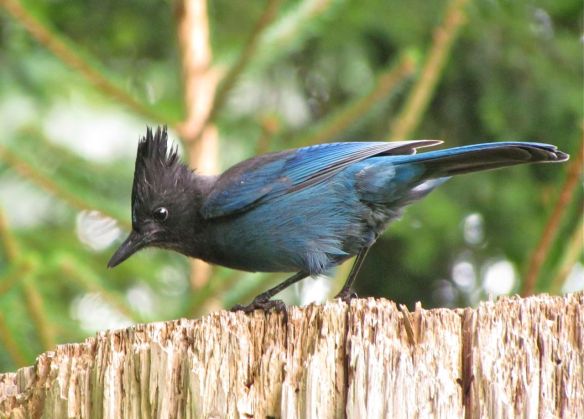Around these parts, many people name our local resident jays, blue jays. Birders like me feel a mild, internal cringe at this minor misnaming, but we usually let it pass without comment. After all, our birds are blue, and they’re definitely jays. The fairly common blue jay of our coastal forests is of course BC’s Provincial bird, the Steller’s Jay. Loud, brash, and with lots of attitude, it fits in well out here on the “left” coast.
Its somewhat shyer Eastern cousin is the real Blue Jay, and we’re incredibly lucky right now to have one visiting a backyard feeder regularly on North Gamma Ave, in North Burnaby.
Common east of the Rocky Mountains and right across southern Canada, Blue Jays are rare visitors to the Lower Mainland, and as far as I’m aware this is the first one we know to visit Burnaby. It’s certainly a new addition to my list of Burnaby birds. Although rare in our region, Blue Jays are expanding their range in BC west of the Rockies. In fact, there is a second Blue Jay in south Vancouver right now. Two Blue Jays in one winter in this region is exceptional.
But let’s enjoy our bird. Compared to its cousin (shown below), the much more familiar Steller’s Jay, the Blue Jay’s blue is a lot paler, and the bird is much more boldly marked. Very similar in shape, size and structure, both birds are attracted to bird feeders and have a particular fondness for nuts of all kinds. Both members of the Cyanocitta genus, they are closely related, and where the two species are found together, they sometimes hybridize.

Blue Jays sport many more colours than our resident Steller’s Jays. Various shades of blue make a showy contrast to areas of black, white, gray and taup – a handsome bird!
While both these birds show quite different shades or colours of blue, their blues have a fascinating connection. For the most part, wherever blue bird feathers are found, including our two jays here, it is not the result of pigmentation. In other words, the feathers are not coloured blue in the way blue jeans are, or blue cars are. At the microscopic level, their feathers have specialized structures that scatter the incoming light to produce the very precise blue colours we see. This is called structural colour. If you found a blue feather from one of these birds and held it up for the light to shine through it, it would look brownish. Here’s to structural colour – our two jays would be a lot drabber without it.
So, if you’re heading up to North Gamma to look for the bird, focus your efforts north of Cambridge Street. A good clue will be other birders and photographers standing around waiting for the bird to put in an appearance. Another clue to the bird’s presence is its distinctive call. Listen out for it, as this bird frequently announces its arrival before putting in an appearance. And please be respectful of people’s homes and privacy.






